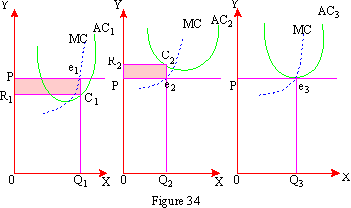|
10.3 Short Run Equilibrium
(A) Three Possibilities: In a competitive
market, price is fixed and given for an individual firm. Moreover,
every firm should earn only normal profits as included in its Average
Cost of production. However, in the short run, different firms may
have a varying degree of efficiency. Their cost structures may differ.
More efficient firms may temporarily earn extra or Super Normal
profits. Less efficient firms may earn Sub Normal profits (losses)
and only optimum efficiency firms will earn normal profits. This
is because of the fact that though equilibrium of a firm depends
upon the MR = MC condition, its profits depend upon the difference
between firms Average Revenue (Price) and Average Cost (AR -
AC) condition. This leaves us with three possibilities.
In an equilibrium with MR = MC, either
i) AR > AC = Super Normal profits
ii) AR < AC = Sub Normal profits, and
iii) AR = AC = Normal profits.
In the long run the presence of Super Normal profits will attract new firms. As new firms enter the market extra profits will be competed away. Similarly inefficient firms with higher costs will start exiting in search of some other opportunity. In the long run, after all adjustments are over only normal profits will be earned by all the firms. In that case not only the MR = MC but the AR = AC condition will also be satisfied by all firms.
(B) Short run equilibrium explained: Let
us study three short run possibilities with varying profits with
the help of a figure.

In Figure 34 we have OP the fixed market price
with MR = AR for the three types of firms. The cost structures of
the firms are different. Let us begin with the first firm which
is more efficient. Its Average Cost curve AC1
passes from below the MR = AR curve. The point e1
marks its equilibrium position where MR = MC. The firm produces
Q1 output. The Total
Revenue of the firm is then,
Similarly the Total Cost of producing this output is,
TC = Output ´
Average Cost = OQ1
´ Q1C1
= OQ1C1R1
Therefore,
Profit = TR - TC = OQ1e1P
- OQ1F1R
= R1C1e1P
This is the Super Normal profit of the firm.
The second firm with AC2
as its Average Cost curve is a less efficient firm. Its Average
Cost curve passes from above the MR = AR curve. In an equilibrium
point e2
we find MR = MC and output level is Q2.
For this output level the firm receives Total Revenue as,
TR = Output ´
Price = OQ2e2P
Total Cost of the firm in equilibrium is,
TC = Output ´ AC
= OQ2C2R2
Hence profits of the firms are,
OQ2C2P
- OQ2C2R2
= - Pe2C2R2
which are negative or subnormal profits. This is because the area of Total Cost is larger than the area of total profits for the second firm.
Finally, there is a third firm with optimum efficiency.
In this case AC3
the average cost curve of the firm is neither above nor below the
MR = AR curve. The two are just tangential at point e3.
The Marginal Cost curve also passes from this point and hence MR
= MC. Equilibrium output is Q3.
For this output level both Total Revenue and Total Costs are equal.
Hence profits of the firm are zero.
TR = TC = OQ3e3P,
TR - TC = Profits = 0
The firm is therefore making only normal profit. Note that in the case of an optimum firm in equilibrium not only MR = MC but also AR = AC. Hence in the long run, full equilibrium condition of a competitive market is that all firms should be of optimum efficiency and should make only normal profits.
[next page]
|